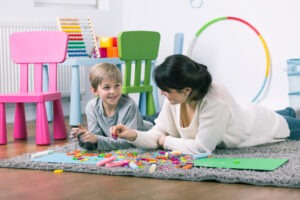Providing Visual Support with Pacing Boards
All speech-language pathologists have their own “toolbox” of materials and tricks that better support, motivate, and engage their clients. Visual supports are a particular favorite tool. From visual schedules to simple yes/no picture cards, children with speech and language disorders benefit from these visual images when communicating.
One of our favorite types of visual support is a pacing board. Simple, versatile, and easy to make, a pacing board can be used to assist with the comprehension and expression of language. Pacing boards for speech therapy can be used for a variety of speech and language disorders, including but not limited to: Articulation and Phonological Disorders, Language Disorders, Fluency, and Childhood Apraxia of Speech. A pacing board can be implemented not only in individual speech sessions, but in the home and at school as well.
A pacing board can be made with a piece of paper and 3-5 drawn dots. When targeting a simple sentence (i.e., “I see the big dog!”), your child can touch each dot as you say each word. A pacing board can also be made with your child’s very own unique design, as well as different materials. For example, you can have your child “smash” three Play-Doh balls when saying the phrase, “I see fish!” or you can align four building blocks and have them touch each block when producing, “I want the glue.” You can even make it into a crafting activity and have your child add their own personal touch by using stickers, personal drawings, pom-pom balls, etc. If you would like to use your pacing board to target multisyllabic words, you can have your child tap out each syllable per target word (i.e., cow-boy-hat).
Below is a list of other ways a pacing board can be used:
- Utterance expansion: model a sentence
- Target multisyllabic words
- Increase fluent speech
- Decrease your child’s rate of speech
- Target medial and final consonant sounds
- Promote independence when practicing skills








